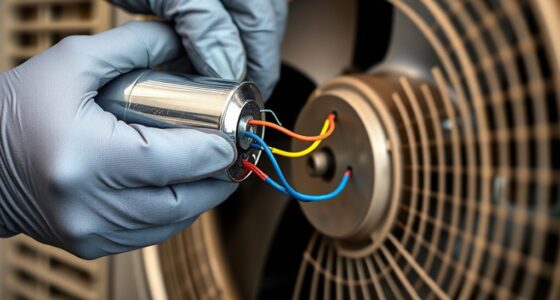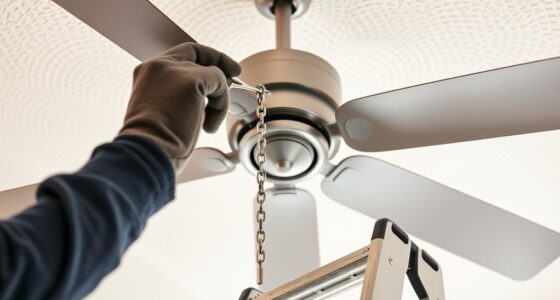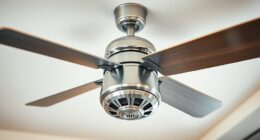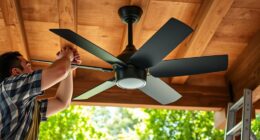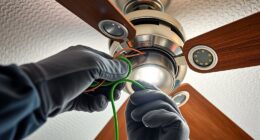To lubricate legacy fan bearings safely, first assess their condition through visual checks and temperature monitoring. Prepare your workspace by cleaning the area, organizing tools, and ensuring proper lighting. Wear PPE such as gloves and goggles, then shut down and lock out the equipment to prevent accidents. Carefully access, clean, and apply the correct lubricant directly into the bearing. Following proper procedures and ongoing monitoring guarantees reliable operation—continue to learn the best practices for lasting maintenance success.
Key Takeaways
- Ensure proper workspace preparation, including cleaning and adequate lighting, before starting lubrication.
- Wear appropriate PPE such as gloves, goggles, and masks to protect against chemical exposure and debris.
- Follow manufacturer guidelines for selecting and applying the correct lubricant type and quantity.
- Turn off power, lock out energy sources, and verify complete de-energization before accessing bearings.
- Monitor bearing temperature and condition during operation to detect issues early and prevent failures.
Assessing the Condition of Legacy Fan Bearings

To properly assess the condition of legacy fan bearings, you need to start with a thorough visual inspection. Look for signs of wear, corrosion, or damage on the bearing surface and housing. Check lubricant viscosity—if it appears thick or greasy, it might indicate contamination or degradation, affecting performance. Examine the bearing material for cracks, pitting, or discoloration, which can signal fatigue or overheating. Listen for unusual noises during operation, as they can point to lubrication issues or bearing deterioration. Confirm that the bearing is properly aligned and not excessively loose or tight. Additionally, verifying adequate lubrication is essential, as insufficient or improper lubrication can accelerate wear and failure. Regular maintenance and bearing condition monitoring can help detect issues early, ensuring the fan operates efficiently and reducing the risk of unexpected failure. Incorporating proper lubrication practices can significantly extend bearing lifespan. By carefully inspecting these aspects, you’ll identify potential problems early, ensuring the fan operates efficiently and reducing the risk of unexpected failure.
Selecting the Appropriate Lubricant

Choosing the right lubricant depends on ensuring compatibility with your fan bearings and considering environmental factors like temperature and moisture. You also need to understand the different lubricant types and their specific applications to keep your bearings running smoothly. By focusing on these points, you can select a lubricant that maximizes performance and extends bearing life. Additionally, selecting lubricants suitable for industrial applications ensures better durability and protection for your bearings over time. Understanding lubricant compatibility is crucial to prevent corrosion and wear, especially in challenging operating conditions. Proper lubrication also involves selecting the right lubricant viscosity to match operational demands and environmental conditions.
Compatibility With Bearings
Selecting the right lubricant for your fan bearings depends on ensuring compatibility with the bearing materials and operating conditions. You need to match lubricant chemistry with the bearing material to prevent corrosion or degradation. Different bearing materials—such as bronze, steel, or composite—react uniquely to various lubricants. Using incompatible lubricant chemistry can lead to increased wear or failure. Proper lubrication also involves understanding bearing maintenance practices to ensure optimal operation. Consulting manufacturer guidelines can help determine the most suitable lubricant based on specific bearing material requirements. Additionally, considering Ford Tuning techniques can provide insights into optimizing machinery performance and longevity.
Environmental Conditions Impact
Environmental conditions play a critical role in determining the right lubricant for your fan bearings, as factors like temperature, humidity, and exposure to contaminants directly affect lubrication performance. You need to evaluate how these elements influence corrosion prevention and overall durability. For example, high humidity can accelerate corrosion, so selecting lubricants with anti-corrosion properties is essential. Environmental monitoring helps identify conditions that may cause lubricant breakdown or contamination. Keep in mind: Vetted – Grobal World environmental factors are vital for selecting the most effective lubrication solutions. Additionally, understanding the potential vulnerabilities of AI systems in industrial applications can help in developing more resilient maintenance protocols, especially considering AI security concerns. Recognizing environmental impacts on lubrication can lead to more informed decisions and better protection for your equipment.
Lubricant Types and Uses
Understanding the different types of lubricants and their specific uses helps guarantee your fan bearings operate smoothly and last longer. Choosing the right lubricant depends on factors like lubricant viscosity, which affects how well it flows at various temperatures, and its biodegradability, important for environmentally conscious operations. For high-temperature environments, you might need a lubricant with a higher viscosity to maintain a protective film, while lighter viscosities suit lower temperatures. Biodegradable lubricants are ideal if environmental impact matters, as they break down more easily without harming ecosystems. Always match the lubricant type to the bearing’s operational requirements, considering viscosity and biodegradability. Additionally, selecting lubricants with appropriate thermal stability ensures they perform effectively under varying temperature conditions, reducing the risk of breakdown or failure. Proper selection ensures suitable performance, reduces maintenance, and extends your fan bearings’ lifespan. Being aware of bearing design can also influence the choice of lubricant, ensuring compatibility and optimal operation. Incorporating regular maintenance practices can further enhance the longevity and efficiency of your bearings, preventing issues before they arise.
Preparing the Workspace for Safe Lubrication

Before you start lubricating the fan bearings, you need to prepare your workspace. Clear the work area of obstructions, gather all necessary tools, and make sure the lighting is bright enough to see clearly. These steps help guarantee your safety and make the process smoother. Additionally, inspecting the equipment for any signs of wear or damage can prevent unexpected issues during lubrication inspection process. Ensuring good spiritual energy in your workspace can also promote a more focused and peaceful environment during maintenance.
Clear the Work Area
To guarantee safety and efficiency when lubricating fan bearings, you need to clear the work area thoroughly. Start by removing any clutter that could cause trips or falls. Use cleaning supplies to wipe down surfaces, removing dust and grease that could contaminate the lubrication. Make certain safety signage is visible, warning others of ongoing maintenance. Clear tools and parts away from the work zone to prevent accidents. Also, check for any spills or leaks, cleaning them immediately. Keeping the workspace organized minimizes hazards and helps you work more efficiently. Additionally, maintaining a clean environment supports proper maintenance practices and extends the lifespan of the equipment. A tidy area also promotes emotional resilience by reducing stress and creating a safer, more controlled environment for the task. Incorporating a regular inspection routine can further identify potential issues before they become safety hazards.
Gather Necessary Tools
Gathering the right tools is essential to guarantee a safe and efficient lubrication process. Start by collecting all necessary equipment, such as screwdrivers, wrenches, lubricants, and rags. Check that your tools are in good condition and properly maintained—this is vital for tool maintenance and safety. Refer to manufacturer specifications to ensure you select the correct lubricants and tools compatible with the fan bearings. Having everything organized before you begin minimizes disruptions and reduces the risk of accidents. Keep a clean workspace to prevent dirt or debris from contaminating the bearings. Properly maintained tools and adherence to manufacturer guidelines set the foundation for a safe, effective lubrication process, helping you avoid damage and prolong the lifespan of the fan bearings. Additionally, understanding the importance of proper maintenance procedures can significantly enhance the longevity and performance of your equipment.
Ensure Adequate Lighting
Making sure adequate lighting is essential for a safe and effective lubrication process. Proper workspace illumination helps you see clearly, preventing mistakes and accidents. Start by checking your lighting setup before beginning. Consider these tips:
- Use bright, focused lights to eliminate shadows and dark spots.
- Position lights to illuminate the fan bearings directly.
- Avoid glare that can strain your eyes or obscure details.
- Use portable or adjustable lighting to adapt to different angles.
Good lighting ensures you can accurately identify lubrication points and handle tools safely. It also reduces eye fatigue, keeping you alert throughout the task. Adequate workspace illumination creates a safer environment, minimizing risks and making sure proper lubrication for fan bearings. Never underestimate the importance of proper lighting in maintaining safe working conditions.
Ensuring Proper Personal Protective Equipment (PPE)

Are you wearing the right personal protective equipment (PPE) before lubricating fan bearings? Making sure you have proper PPE is vital for safety. Start with safety gloves to protect your hands from sharp edges, hot surfaces, and chemicals. Verify your gloves are sturdy and suitable for chemical contact and mechanical protection. Wear eye protection, like safety goggles, to guard against splashes or debris. A long-sleeved shirt and durable pants help shield your skin from potential spills. Don’t forget a dust mask or respirator if dust or fumes are present. PPE creates a barrier between you and hazards, reducing injury risk. Always inspect your equipment before starting and confirm it fits correctly. Proper PPE is a simple but essential step for safe, effective lubrication of fan bearings.
Shutting Down and Locking Out Equipment

Before starting maintenance on fan bearings, you must shut down the equipment and implement lockout procedures to prevent accidental startup. Proper lockout procedures ensure safety and compliance. First, turn off the fan and disconnect it from power sources. Then, follow these key steps:
- Apply equipment tagging to indicate maintenance is in progress.
- Lock out all energy sources using lockout devices.
- Verify that the equipment is completely de-energized.
- Communicate with your team to confirm lockout is in place.
These steps protect you from unexpected startup or release of stored energy. Always double-check that all energy sources are isolated before proceeding. Proper equipment tagging and lockout procedures are essential for a safe maintenance environment.
Accessing and Cleaning the Bearing Area
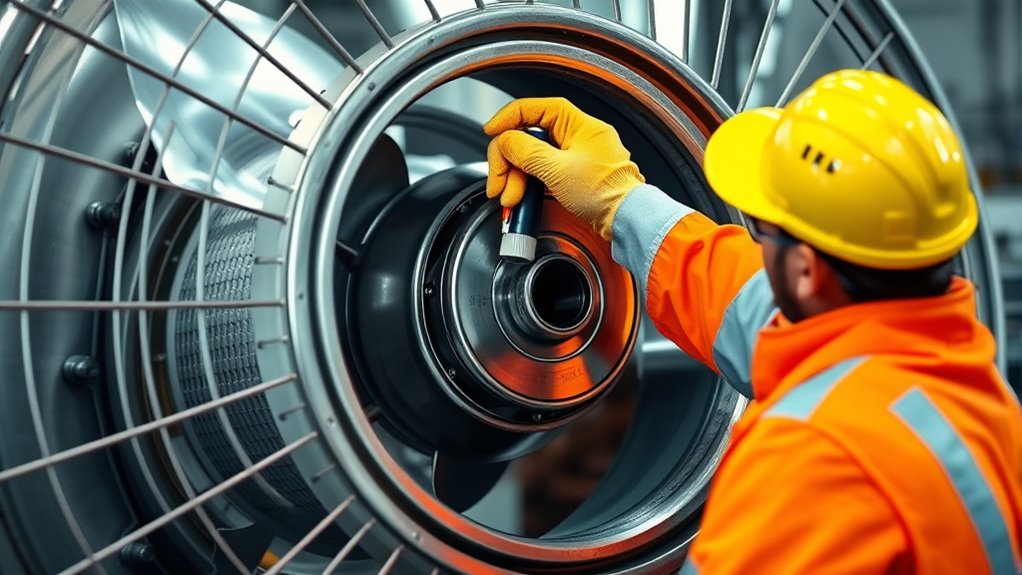
Once you’ve confirmed that the equipment is fully de-energized and locked out, you can access the bearing area. Carefully remove any covers or guards to expose the bearings. Use a clean, lint-free cloth to wipe away dust, dirt, and old lubricant, which helps prevent contamination and ensures proper lubrication frequency. Be mindful of bearing materials, as some may be sensitive to certain cleaning agents. When cleaning, avoid harsh chemicals that could damage the bearings. Proper access allows you to inspect for signs of wear or corrosion. Here’s a quick reference:
| Bearing Material | Cleaning Method | Inspection Focus |
|---|---|---|
| Steel | Mild degreaser, cloth | Wear, corrosion |
| Bronze | Gentle brush, solvent | Cracks, debris |
| Composite | Soft brush, damp cloth | Material integrity |
Applying Lubricant Correctly and Safely

To guarantee ideal lubrication and prevent bearing failure, it’s crucial to apply lubricant correctly and safely. Use the right type and amount of lubricant, avoiding over-application that can increase bearing temperature. When applying, ensure a steady flow directly into the bearing without spillage. Afterward, dispose of excess lubricant properly, following local regulations for lubricant disposal. Keep an eye on bearing temperature during operation; if it rises unexpectedly, stop and reassess. Remember to wear protective gear to prevent skin contact and inhalation risks. Proper application reduces friction, prevents overheating, and extends bearing life. Carefully controlling the amount and method of lubrication helps maintain optimal bearing performance and safety.
Verifying Proper Lubrication and Operation

Verifying proper lubrication and operation is essential to guarantee your fan bearings function reliably and efficiently. First, check the lubricant viscosity; it should match the manufacturer’s specifications for your bearing’s operating conditions. Too thick or too thin lubricant can cause issues like increased friction or inadequate lubrication. Next, monitor bearing temperature regularly—excessive heat indicates insufficient lubrication or other problems. Use a thermometer or thermal sensor to track temperature during operation. If temperatures rise above recommended levels, it signals the need for immediate inspection and possible lubrication adjustment. Ensuring correct lubricant viscosity and maintaining ideal bearing temperature help prevent premature wear, reduce downtime, and extend bearing life. Consistent verification keeps your fan system running smoothly and efficiently.
Implementing a Maintenance and Monitoring Schedule
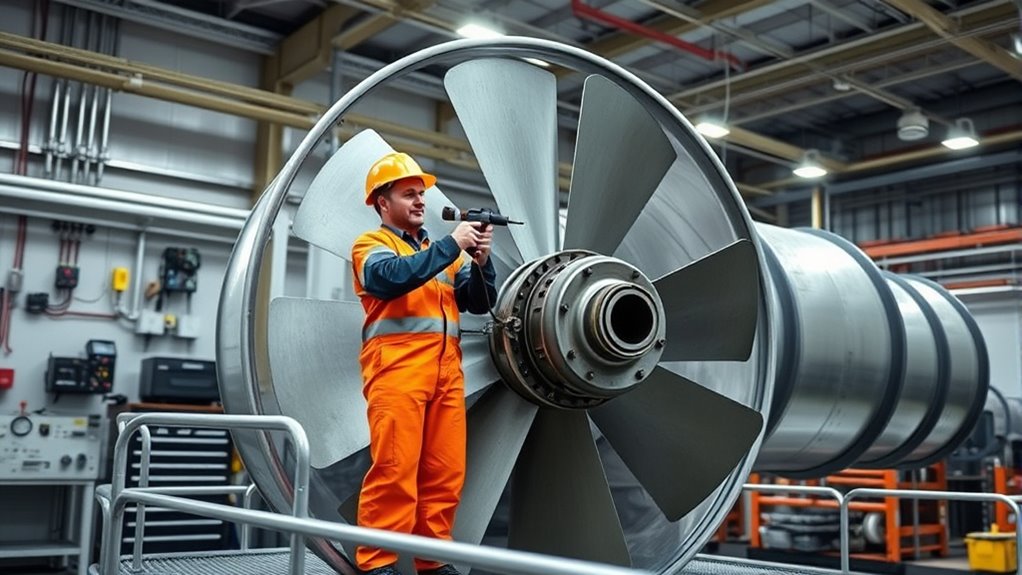
Developing a structured maintenance and monitoring schedule is essential to keep your fan bearings operating reliably. Regularly check lubrication frequency to prevent over- or under-lubrication, which can cause bearing failure. Monitor bearing temperature consistently, as rising temperatures may indicate lubrication issues or excessive wear. To stay ahead, consider these points:
- Schedule lubrication based on manufacturer recommendations and operating conditions
- Track bearing temperature trends over time
- Conduct visual inspections for signs of wear or contamination
- Record maintenance activities and observations for future reference
Frequently Asked Questions
How Often Should Legacy Fan Bearings Be Lubricated?
You should lubricate legacy fan bearings regularly to guarantee ideal performance. Typically, check the bearings and perform lubricant compatibility assessments every 3 to 6 months, depending on usage. During bearing inspection, look for signs of wear or contamination. Using the correct lubricant is essential; always verify compatibility to prevent damage. Consistent maintenance helps prolong bearing life and keeps your fan operating smoothly.
What Are Common Signs of Bearing Failure?
Did you know that bearing failure accounts for up to 40% of equipment downtime? Common signs include unusual noises, like grinding or squealing, which indicate issues with lubricant compatibility or inadequate lubrication. You should perform regular bearing inspections to catch early problems. If you notice increased vibration, temperature spikes, or lubricant contamination, address them promptly to prevent costly failures and guarantee smooth operation.
Can Different Lubricants Be Mixed Safely?
When considering if different lubricants can be mixed safely, you should always check lubricant compatibility first. Mixing incompatible lubricants can lead to mixing hazards, such as chemical reactions that impair bearing performance or cause damage. You prevent these risks by selecting lubricants designed for compatibility and never combining products without verifying their compatibility. This careful approach ensures the longevity and safe operation of your fan bearings.
What Are the Risks of Over-Lubricating Bearings?
You might think more lubrication helps, but over-lubricating bearings can cause serious over lubrication hazards. Excess grease or oil can lead to bearing contamination, trapping dirt and debris that accelerate wear. This not only risks bearing failure but also increases maintenance costs. Keep a balanced lubrication schedule to prevent these issues, ensuring your fan operates smoothly without the dangers of over-lubrication.
How to Dispose of Used Lubricant Responsibly?
When disposing of used lubricant, you should consider the environmental impact and follow proper disposal methods. You can’t just pour it down drains or onto the ground, as it harms ecosystems. Instead, take it to a licensed collection center or recycling facility that accepts industrial lubricants. Proper disposal helps prevent pollution and complies with environmental regulations, ensuring safety for everyone and protecting the environment.
Conclusion
By following these safe lubrication steps, you guarantee your legacy fan bearings stay reliable and efficient. Think of it like maintaining a vintage car—you might believe it’s too old to fix, but proper care can keep it running smoothly for years. Regular checks and correct lubrication aren’t just maintenance tasks; they’re investments in your equipment’s longevity. So, treat your bearings well, and they’ll keep working seamlessly, proving that good care defies age.



